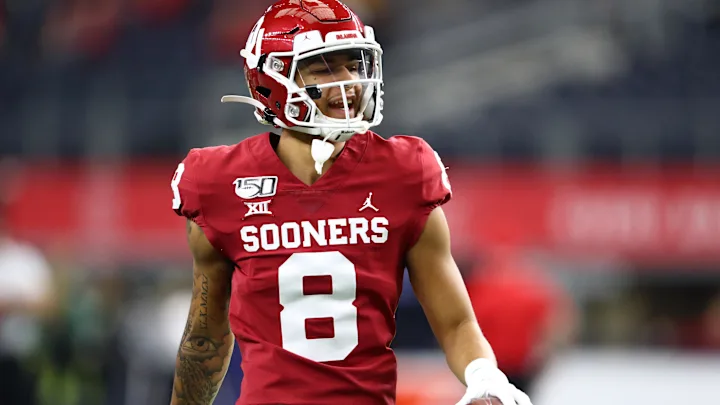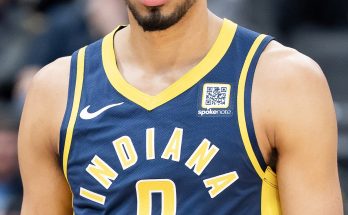In the ever-evolving world of college football, the transfer portal has become one of the most powerful and influential tools available to athletes and coaches alike. It has reshaped the landscape of recruitment, player movement, and team dynamics. One of the most significant stories to emerge in recent years is the decision by a former five-star wide receiver for the University of Oklahoma to enter the transfer portal. This announcement, which reverberated throughout the college football community, has sparked a wide range of discussions regarding the reasons behind the move, the implications for the Sooners, and the broader trends within college football that the transfer portal highlights.
The player in question, once heralded as one of the top recruits in the nation, was expected to make an immediate impact at Oklahoma and play a key role in the team’s offensive success. His decision to enter the transfer portal, however, signals a shift in both his personal career trajectory and in the culture of college football as a whole. To understand the full scope of this decision, it is important to explore the implications of his transfer, the rise of the portal as a key aspect of college sports, and what this means for the University of Oklahoma’s football program moving forward.
The Rise of the Transfer Portal in College Football
Before diving into the specific reasons for the wide receiver’s decision, it’s crucial to understand the role the transfer portal plays in modern college football. Since its introduction in 2018, the transfer portal has become a game-changer. It gives players the ability to enter their name into a database, from which they can be contacted by other universities, facilitating transfers between programs. This change in policy allowed players more control over their careers, empowering them to seek new opportunities when they felt their current situation wasn’t ideal.
In the past, transferring was often a cumbersome process that involved complex paperwork, waiver requests, and eligibility restrictions. Now, the portal has streamlined that process, providing student-athletes with more freedom and flexibility to pursue their goals. With this newfound autonomy, many players are opting to transfer, whether due to lack of playing time, a change in coaching staff, personal reasons, or a desire for a fresh start in a new program.
The transfer portal has led to a seismic shift in college football. Schools must now constantly be on alert, aware that their star players might transfer at any given moment. On the flip side, players are no longer tethered to a program they feel is not serving their best interests, allowing them to pursue an environment where they can thrive. For players like the former five-star Oklahoma wide receiver, the portal provides an opportunity to escape what they perceive as an unfavorable situation and find a better fit.
The Former Five-Star Receiver at Oklahoma
The former five-star wide receiver who recently announced his intention to enter the transfer portal had been highly sought after during his recruitment. Widely regarded as one of the top high school prospects in the country, his skills on the field were undeniable. A combination of size, speed, and agility made him an instant standout, and many expected him to become a cornerstone of Oklahoma’s high-powered offense.
When he committed to Oklahoma, expectations were high. The Sooners had developed a reputation for producing some of the best wide receivers in the nation, including recent stars like CeeDee Lamb, Marquise “Hollywood” Brown, and others who had gone on to successful careers in the NFL. Oklahoma’s air raid offense, spearheaded by the dynamic quarterback play, had turned the program into a powerhouse for developing wide receivers. It seemed like the perfect fit for a player of this caliber.
However, despite the lofty expectations and the potential for stardom, things didn’t go as planned for the young wide receiver. Whether due to injury, inconsistency in performance, or simply a failure to fit into the system, the player struggled to make the immediate impact that many had anticipated. Oklahoma’s coaching staff, while talented, had its own set of challenges in developing the offense and adjusting to the rapidly changing landscape of college football. The emergence of new players and the shifting focus within the team may have led the wide receiver to feel as though he was no longer in the best environment to reach his full potential.
The decision to enter the transfer portal is often seen as a way for players to take control of their future and seek out a situation that offers more opportunities, better fits with their skills, or a fresh start in a new program. This particular wide receiver’s move represents not only a personal decision but also a reflection of the pressures and challenges that modern college athletes face.
The Reasons Behind the Transfer Decision
Several factors could be contributing to the wide receiver’s decision to enter the transfer portal. While the player has not fully disclosed all the reasons behind his choice, it is possible to hypothesize several potential motivations based on common trends in college football.
- Lack of Playing Time: One of the most frequent reasons players transfer is a lack of playing time. The highly competitive nature of college football means that even the most talented recruits can struggle to find consistent opportunities, particularly when there are upperclassmen ahead of them or a deep depth chart at their position. If the player was not seeing significant snaps or failing to contribute in the ways he expected, transferring to another program might provide him with the chance to get more playing time and prove his worth.
- Coaching and Scheme Fit: College football programs constantly evolve, and coaching staff changes are common. A new coaching regime can often change the offensive or defensive philosophy, which may not align with a player’s strengths. If the offensive scheme at Oklahoma didn’t play to the wide receiver’s strengths or if there was a lack of rapport with the coaching staff, the player might have felt that a change of scenery would allow him to develop in a system more suited to his abilities.
- Injuries: Injuries are an unfortunate reality in college football, and they can severely impact a player’s development and playing time. If the wide receiver had been dealing with injuries that slowed his progress or prevented him from reaching his peak form, he might have decided that transferring to a new program would offer a better chance at a fresh start and a more conducive environment for recovery.
- Personal Reasons: Sometimes, the decision to transfer is driven by personal factors that go beyond football. A player may want to be closer to home, pursue a different academic path, or seek a change in their overall environment. These decisions can be difficult to understand from the outside, but personal happiness and well-being are critical factors in any college athlete’s decision-making process.
- Competition and Depth at Oklahoma: Oklahoma has been home to some of the most talented athletes in the country, especially at the wide receiver position. The player may have found himself in a highly competitive position with numerous talented teammates vying for the same opportunities. This increased competition can make it harder for a player to stand out, leading to frustration and the desire to find a new program where he might be able to play a more prominent role.
The Impact on Oklahoma’s Football Program
The decision of a five-star recruit to enter the transfer portal is always significant for a football program, especially one as prestigious as Oklahoma. For the Sooners, losing a player of this caliber can have both short-term and long-term consequences.
In the short term, the loss of the wide receiver creates a gap in the depth chart. The Sooners will need to find ways to fill that void, either by promoting players from within the program or by looking to the transfer portal themselves. Oklahoma has historically been strong in its recruiting efforts and has developed a deep talent pool, but losing a key player can still be a setback.
In the long term, however, this situation reflects a broader trend in college football—the increased volatility of rosters due to the transfer portal. For Oklahoma, this means the program may need to adjust its approach to roster management. While the transfer portal provides opportunities for adding new talent, it also creates uncertainty, as programs can lose talented players at any time. This dynamic could require Oklahoma’s coaching staff to adapt in terms of recruitment, player development, and team culture.
The loss of the wide receiver may also have a psychological impact on the team. Players often look up to highly ranked recruits and expect them to be cornerstones of the program. If a player of that caliber transfers, it can create questions among teammates and fans about the stability and future direction of the program.
The Broader Implications
The decision by a former five-star wide receiver for Oklahoma to enter the transfer portal is a reminder of the complexities and challenges that come with being a college athlete in today’s world. While the transfer portal provides athletes with opportunities for growth and new beginnings, it also creates a level of uncertainty that can affect both players and programs. For the wide receiver, the transfer portal is a path to new possibilities, while for Oklahoma, it’s a sign of the changing dynamics in college football.
As college football continues to evolve, the transfer portal will play an increasingly pivotal role in shaping the landscape of the sport. The decision by this wide receiver is just one example of how the portal can dramatically alter a player’s career path and a program’s future. How Oklahoma responds to this challenge and adapts to the shifting realities of the college football world will be critical to its continued success. For players, coaches, and fans alike, the transfer portal represents both opportunity and risk, making it one of the most important developments in the modern era of college football.



